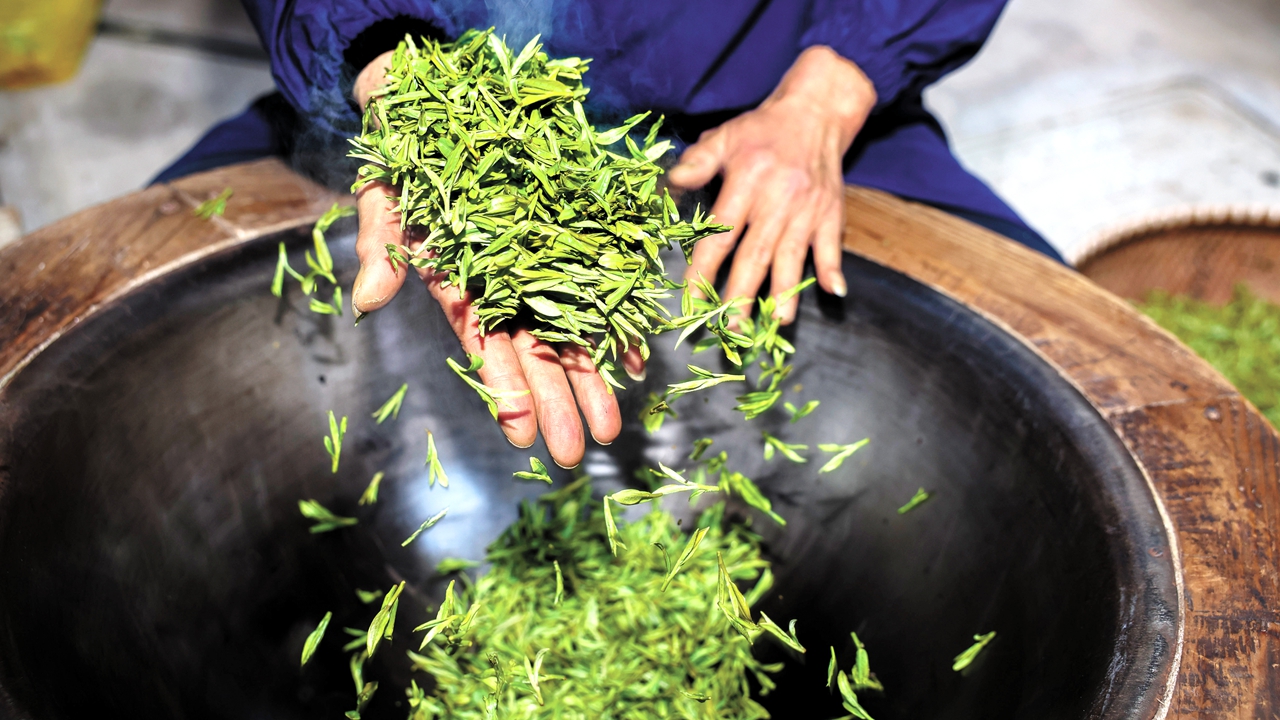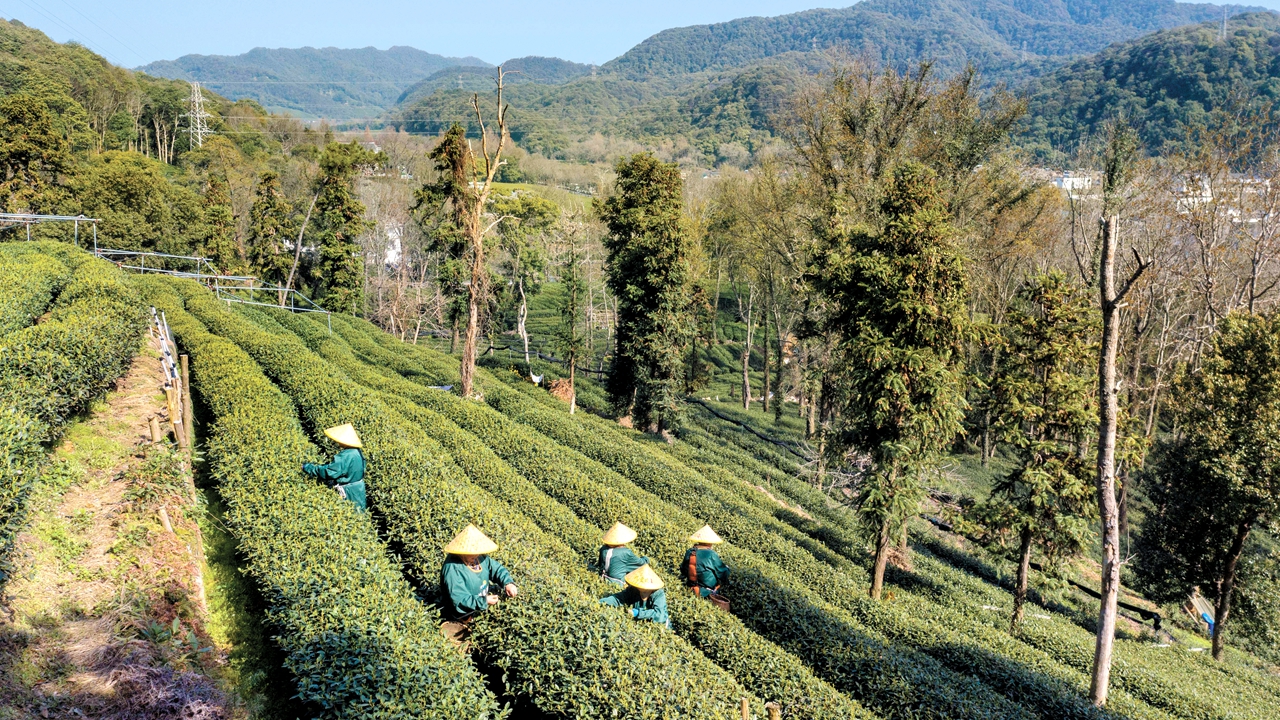A taste of spring in Longjing tea hills
Writer: Li Dan | Editor: Zhang Zeling | From: Shenzhen Daily | Updated: 2024-04-01
With Longjing tea leaves entering their peak harvest season last Wednesday, tea farmers in Hangzhou, Zhejiang Province are racing against the clock to pick the tender leaves that have been their prized specialty since ancient times. Literally translated as Dragon Well tea, Longjing tea is a pan-roasted green tea from the area surrounding Longjing Village near West Lake. Containing vitamin C, amino acids, and like most fine Chinese green teas, high concentrations of catechins, Longjing tea is produced mostly by hand and renowned for its green color, delicate aroma, mellow taste, and beautiful shape.

Longjing tea, a choice green tea, is mostly produced by hand. Photos by Xinhua
Tea trees have been planted as early as the Tang Dynasty (618-907) in the West Lake region. Longjing tea became famous in the Song Dynasty (960-1279), with poets such as Qin Guan writing poems and essays about tours to the tea gardens while praising the superb taste of the tea. Legend has it that Emperor Qianlong of the Qing Dynasty (1644-1911) visited the Longjing tea-producing regions four times during his six tours to the south of the Yangtze River. A huge fan, the emperor gave Longjing tea as gifts to the court ministers close to him, further helping to promote its fame.
The five main production regions are Shifeng Hill (Lion Peak), Longjing Village, Wuyun Hill, Hupao Temple, and Meijiawu Village.
Longjing Village
Located to the southwest of West Lake and embraced by hills at its northwest, Longjing Village boasts 53 hectares of hillside tea gardens. Standing in the village, people will see nothing but tea trees in every direction, and the village all surrounded by green hills covered by tea trees. Following an uphill trail named Langdangling, one will come across hospitable local farmers at the gate of their tea gardens, inviting tourists to have a sip of their newly picked tea. The bustling crowds are left behind, and one can’t help wondering if this is really in the heart of Hangzhou and near the West Lake, a hot tourist destination with thousands fighting for a spot to take photos.

Local farmers in Meijiawu Village have entered the Longjing tea peak harvest season in late March.
As the tender tea trees are sensitive to the harm of strong sunlight, farmers often build canopies over their prized shrubs in low-altitude tea gardens, which is not necessary in the hillside tea gardens. Towering trees sift the rays, making a natural canopy for the tea shrubs; the slopes allow rainwater to flow through the soil and help the tea tree roots to breathe more freely; the mosses and herbs close to the soil also help to retain and enrich the soil.
Faxi Temple
Legend has it that Monk Biancai of the Song Dynasty led his disciples to plant tea trees on Shifeng Hill for their own use. Today, tea gardens can still be found near Faxi Temple. With lower temperatures at a higher altitude, the tea leaves bud later and are therefore harvested later than in the gardens at the hill foot. With no fertilizers or pesticides used in the tea gardens near the temple, the longer wait for a sip of the Longjing tea produced here is worthwhile.
Another well-known story about Monk Biancai involves Su Shi, the Song poet after whom the West Lake’s Su Causeway was named. During one visit to the temple, Su found a kindred soul in the monk and the two talked late into the night. The next day, when the monk saw his friend off, the two continued to chat as they walked, until Biancai realized he had broken the temple’s rule that monks could not bid farewell to friends at the farther side of the Huxi Creek. A pavilion named “Guoxi,” which means “crossing the creek,” was later built to mark their friendship. The pavilion is by an ancient trail in the valley beneath Fenghuang Ridge today, flanked by lush woods and bamboos on one side and a meandering creek on the other.
Manjuelong Village
Each year between Qingming, or Tomb Sweeping Day, and Grain Rain, that is, from early April to mid-May, the tea frying masters of Manjuelong Village have little time to rest. The refreshing aroma of green tea is so strong that the whole village is literally soaked in it. Following a secluded path up the hill to Baihe Peak, one will arrive at the tea garden treasured by its owner Hu Junhui. Unlike his neighbors, Hu has let his tea trees grow freely and has not pruned them for 10 years. “Tea harvested from such unpruned trees tastes stronger and its aroma lingers longer in the mouth,” he said. An inheritor of national intangible cultural heritage, Hu won a first prize in tea frying several years ago.
In the Siyanjing Community near Hupao Temple, another tea culture inheritor is working on her own experiment. Zhang Mengyi, the granddaughter of tea master Yang Jichang, is catering to a young demographic and adding various flavors to Longjing tea. In her creations, people can taste the prized tea with the aromas of roses, grapes, or pears.
For thousands of years, the hilly villages by the West Lake have been wrapped in the aroma of tea in spring, awaiting curious visitors to try their Longjing tea.